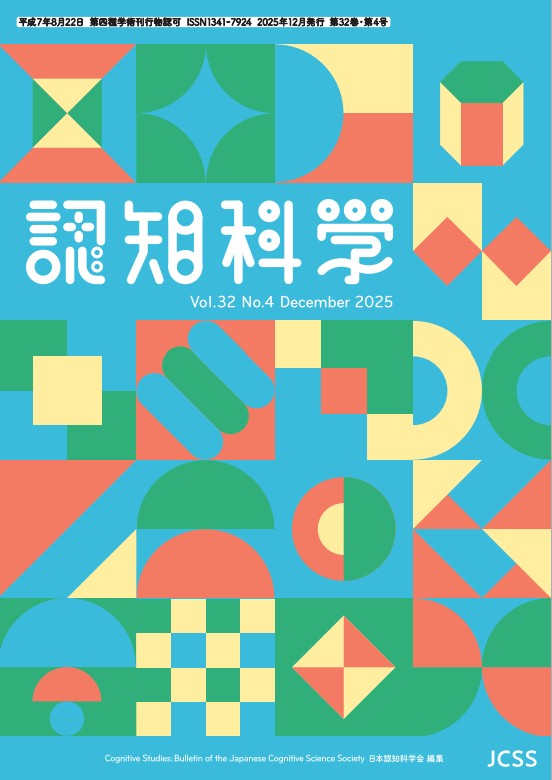最新号
認知科学
選択された号の論文の28件中1~28を表示しています
- |<
- <
- 1
- >
- >|
巻頭言
-
原稿種別: 巻頭言
2025 年32 巻4 号 p. 461-462
発行日: 2025/12/01
公開日: 2025/12/15
PDF形式でダウンロード (158K)
受賞者の言葉
-
原稿種別: その他
2025 年32 巻4 号 p. 463-464
発行日: 2025/12/01
公開日: 2025/12/15
PDF形式でダウンロード (165K) -
原稿種別: 受賞者の言葉
2025 年32 巻4 号 p. 465-466
発行日: 2025/12/01
公開日: 2025/12/15
PDF形式でダウンロード (1123K) -
原稿種別: 受賞者の言葉
2025 年32 巻4 号 p. 467-468
発行日: 2025/12/01
公開日: 2025/12/15
PDF形式でダウンロード (447K) -
原稿種別: 受賞者の言葉
2025 年32 巻4 号 p. 469-470
発行日: 2025/12/01
公開日: 2025/12/15
PDF形式でダウンロード (321K)
研究論文
-
原稿種別: 研究論文
2025 年32 巻4 号 p. 471-485
発行日: 2025年
公開日: 2025/12/15
[早期公開] 公開日: 2025/09/15PDF形式でダウンロード (15125K) -
原稿種別: 研究論文
2025 年32 巻4 号 p. 486-498
発行日: 2025年
公開日: 2025/12/15
[早期公開] 公開日: 2025/09/15PDF形式でダウンロード (1888K) -
原稿種別: 研究論文
2025 年32 巻4 号 p. 499-513
発行日: 2025/12/01
公開日: 2025/12/15
PDF形式でダウンロード (3503K) -
原稿種別: 研究論文
2025 年32 巻4 号 p. 514-529
発行日: 2025/12/01
公開日: 2025/12/15
PDF形式でダウンロード (1896K) -
原稿種別: 研究論文
2025 年32 巻4 号 p. 530-542
発行日: 2025/12/01
公開日: 2025/12/15
PDF形式でダウンロード (1079K)
短報論文
-
原稿種別: 短報論文
2025 年32 巻4 号 p. 543-547
発行日: 2025/12/01
公開日: 2025/12/15
PDF形式でダウンロード (567K)
誌上討論 ローカルエコーチェンバーのステアリングに向けた認知研究
-
原稿種別: その他
2025 年32 巻4 号 p. 548-551
発行日: 2025/12/01
公開日: 2025/12/15
PDF形式でダウンロード (409K) -
原稿種別: 誌上討論
2025 年32 巻4 号 p. 552-562
発行日: 2025/12/01
公開日: 2025/12/15
PDF形式でダウンロード (4720K) -
原稿種別: 誌上討論
2025 年32 巻4 号 p. 563-565
発行日: 2025/12/01
公開日: 2025/12/15
PDF形式でダウンロード (219K) -
原稿種別: 誌上討論
2025 年32 巻4 号 p. 566-568
発行日: 2025/12/01
公開日: 2025/12/15
PDF形式でダウンロード (398K) -
原稿種別: 誌上討論
2025 年32 巻4 号 p. 569-572
発行日: 2025/12/01
公開日: 2025/12/15
PDF形式でダウンロード (370K) -
原稿種別: 誌上討論
2025 年32 巻4 号 p. 573-576
発行日: 2025/12/01
公開日: 2025/12/15
PDF形式でダウンロード (456K)
解説特集 認知科学とリハビリテーションの接続
-
原稿種別: その他
2025 年32 巻4 号 p. 577
発行日: 2025/12/01
公開日: 2025/12/15
PDF形式でダウンロード (118K) -
原稿種別: 解説
2025 年32 巻4 号 p. 578-588
発行日: 2025/12/01
公開日: 2025/12/15
PDF形式でダウンロード (607K) -
原稿種別: 解説
2025 年32 巻4 号 p. 589-597
発行日: 2025/12/01
公開日: 2025/12/15
PDF形式でダウンロード (708K) -
原稿種別: 解説
2025 年32 巻4 号 p. 598-607
発行日: 2025/12/01
公開日: 2025/12/15
PDF形式でダウンロード (1599K)
文献紹介
-
原稿種別: 文献紹介
2025 年32 巻4 号 p. 608-613
発行日: 2025/12/01
公開日: 2025/12/15
PDF形式でダウンロード (279K)
書評
-
原稿種別: 書評
2025 年32 巻4 号 p. 614-615
発行日: 2025/12/01
公開日: 2025/12/15
PDF形式でダウンロード (177K) -
原稿種別: 書評
2025 年32 巻4 号 p. 616-617
発行日: 2025/12/01
公開日: 2025/12/15
PDF形式でダウンロード (215K) -
原稿種別: 書評
2025 年32 巻4 号 p. 618-619
発行日: 2025/12/01
公開日: 2025/12/15
PDF形式でダウンロード (197K)
会議報告
-
原稿種別: 会議報告
2025 年32 巻4 号 p. 620-624
発行日: 2025/12/01
公開日: 2025/12/15
PDF形式でダウンロード (1330K) -
原稿種別: 会議報告
2025 年32 巻4 号 p. 625-627
発行日: 2025/12/01
公開日: 2025/12/15
PDF形式でダウンロード (229K) -
原稿種別: 会議報告
2025 年32 巻4 号 p. 628-629
発行日: 2025/12/01
公開日: 2025/12/15
PDF形式でダウンロード (185K)
- |<
- <
- 1
- >
- >|
